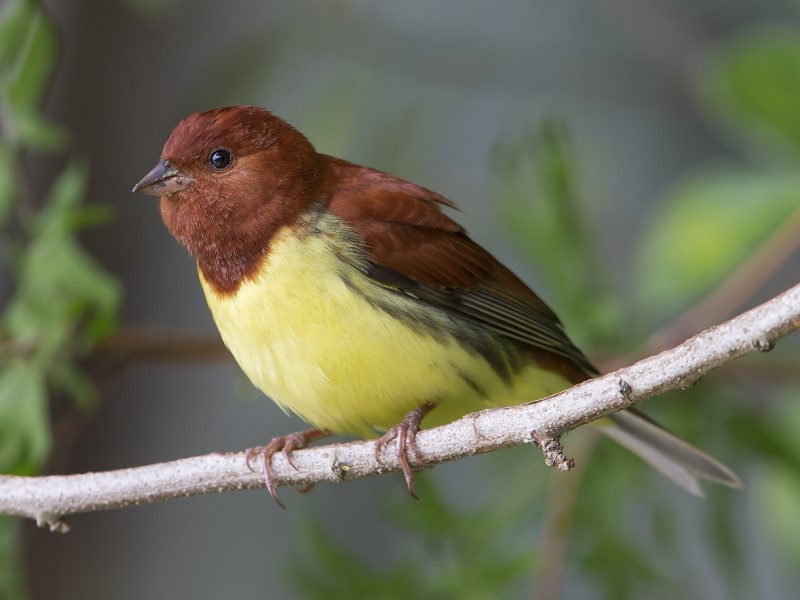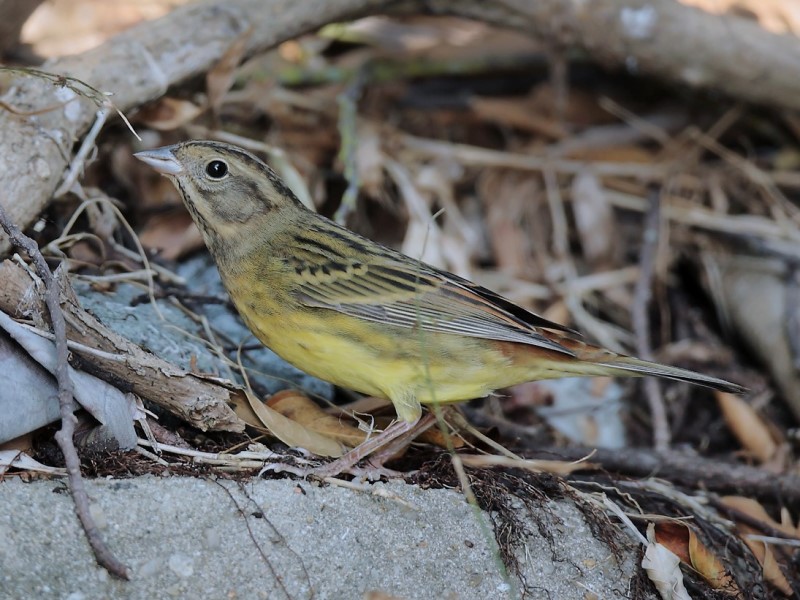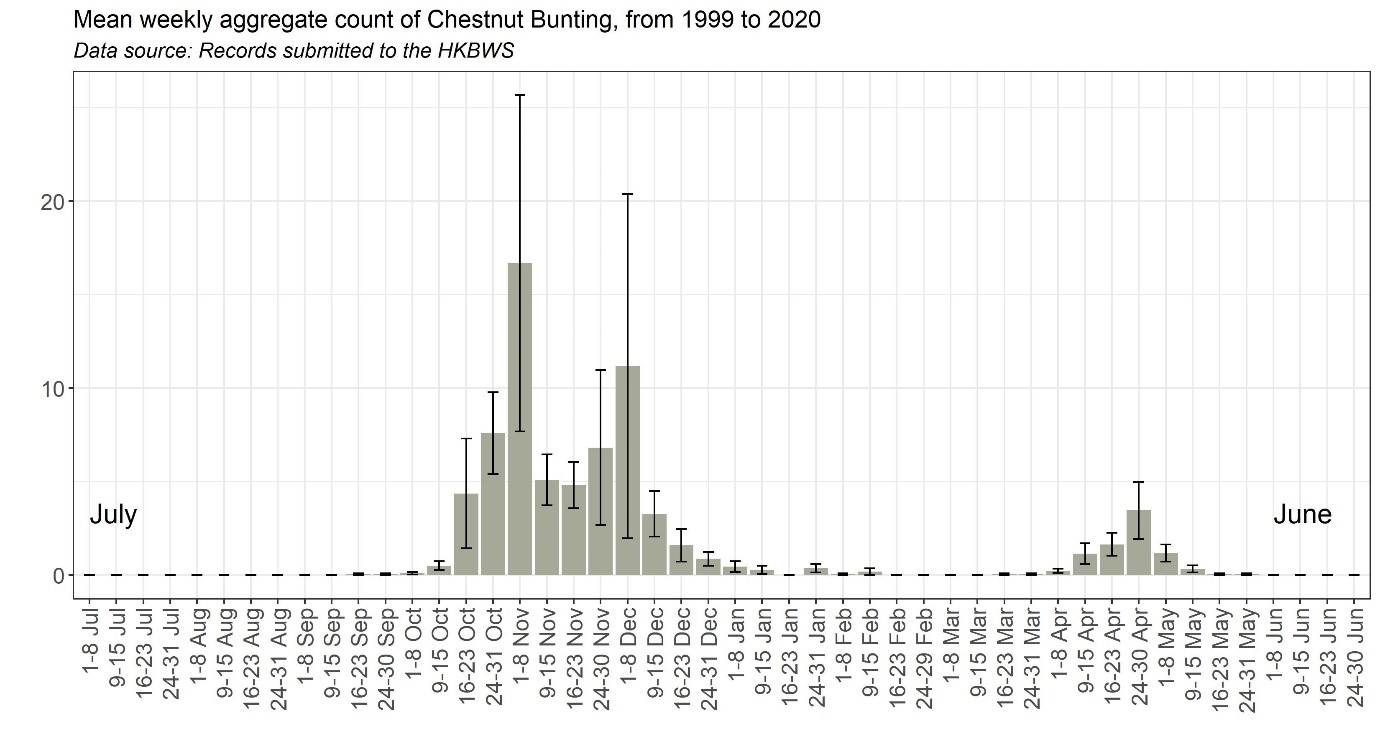Chestnut Bunting Emberiza rutila 栗鵐
Category I. Passage migrant, common in autumn but scarce in spring, and rare winter visitor; occurs mainly in shrubland and forest-edge.
IDENTIFICATION

Apr. 2013, Martin Hale. Adult male.
In all plumages has chestnut rump and undertail coverts, very little white in the tail and at least some yellow on the underparts,. Adult male in breeding plumage very distinctive with chestnut head, upper chest, mantle to rump, scapulars, coverts and edges to tertials and inner secondaries, and yellow underparts with diffuse greyish streaking on flanks. In winter chestnut areas supressed by pale fringes to feathers, especially on the chest.

Nov. 2008. Michelle and Peter Wong. First-winter female.
The female is relatively poorly-marked apart from a broad pale submoustachial bordered below by dark malar, greyish-buff throat, rufous confined to rump and diffuse streaking on yellowish underparts. Resembles Yellow-breasted Bunting but differs in less boldly patterned head, creamy throat with obvious dark streaks at side and little white in tail (Shirihai and Svensson 2018).

Apr. 2008, Michelle and Peter Wong. Second calendar-year male.
Young males resemble adult female but often have chestnut on head and sometimes on scapulars and wing coverts.
VOCALISATIONS
Recordings of this species are currently restricted on Xeno-canto. The typical call ‘tik’ is similar to that of Tristram’s Bunting in being high-pitched.
DISTRIBUTION & HABITAT PREFERENCE
In HK, Chestnut Bunting is probably the Emberiza species that most favours hillside shrubland, especially in autumn when it is the commonest bunting in this habitat, and it is relatively rare in other habitats. Small numbers occur at Long Valley, where it does not seem to be particularly attracted to rice paddy, and it is also found in forest and forest-edge. In this last habitat occasional birds are often found with other buntings, but in its preferred habitat it more often occurs on its own in flocks of up to 30 birds. It is generally rare in fish pond areas.
OCCURRENCE
Chalmers (1986) considered Chestnut Bunting to be an irregular and uncommon passage migrant, but due to a ringing programme in its favoured habitat at Kadoorie Agricultural Research Centre (ARC) and a consequent better understanding of its habitat preferences, by the end of the 1990s it was clear that it was a regular passage migrant from mid-October to mid-December (Figure 1) and is the commonest bunting in hillside shrubland during November. The associated early morning watches showed that large numbers regularly pass at this time of year, and the numbers recorded on the ground are only a small proportion of the numbers moving through. Counts were typically of up to 50 birds, with the highest single day count recorded being 150 passing over on 7 November 1992 and 39 trapped there on the same date. The highest count on record, however, is 200 at KFBG on 6 November 2000.
Flocks occasionally remain in favoured localities for a few days; for example, up to 120 were present at Sha Lo Tung from 21 November to 5 December 1993, but few birds spend the winter in HK.
Spring passage occurs mainly during April, with relatively more records from the hills of HK Island and the Deep Bay area than in autumn. Extreme dates are 16 May 2008 and 21 September 2019. Numbers are usually lower than in autumn and vary from year to year, but an exceptional count of 150 was made at Mai Po on 27 April 1988. It is difficult to discern any change in numbers as hillside shrubland is not covered as regularly as it was in the 1990s when a ringing programme was carried out at Kadoorie ARC.
On the migration hotspot of Po Toi it has been recorded in spring from 25 March to 16 May and in autumn from 3 October to early December, with only two records in the second half of December and one in January.
Chestnut Bunting was not recorded in HK until 25 April 1953 (Dove and Goodhart 1955) and not recorded annually until 1975.
BEHAVIOUR, FORAGING & DIET
Seen feeding on seeds but no details.
RANGE & SYSTEMATICS
Monotypic. Breeds in south and southeast Siberia extending into northern Mongolia and northeast China; winters in coastal provinces of south China and northern Indochina. In China breeds in the far northeast and winters south of the Chang Jiang (Yangtze River) (Liu and Chen 2021).
CONSERVATION STATUS
IUCN: Least Concern. Population trend stable.
Figure 1.

Chalmers, M. L. (1986). Annotated Checklist of the Birds of Hong Kong. Hong Kong Bird Watching Society, Hong Kong.
Dove, R. S. and H. J. Goodhart (1955). Field observations from the Colony of Hong Kong. Ibis 97: 311-340.
Liu, Y. and S. H. Chen (eds) (2021). The CNG Field Guide to the Birds of China (in Chinese). Hunan Science and Technology Publication House, Changsha.
Shirihai, H. and L. Svensson (2018). Handbook of Western Palearctic Birds Vol. 2. Passerines: Flycatchers to Buntings. Helm, London.

